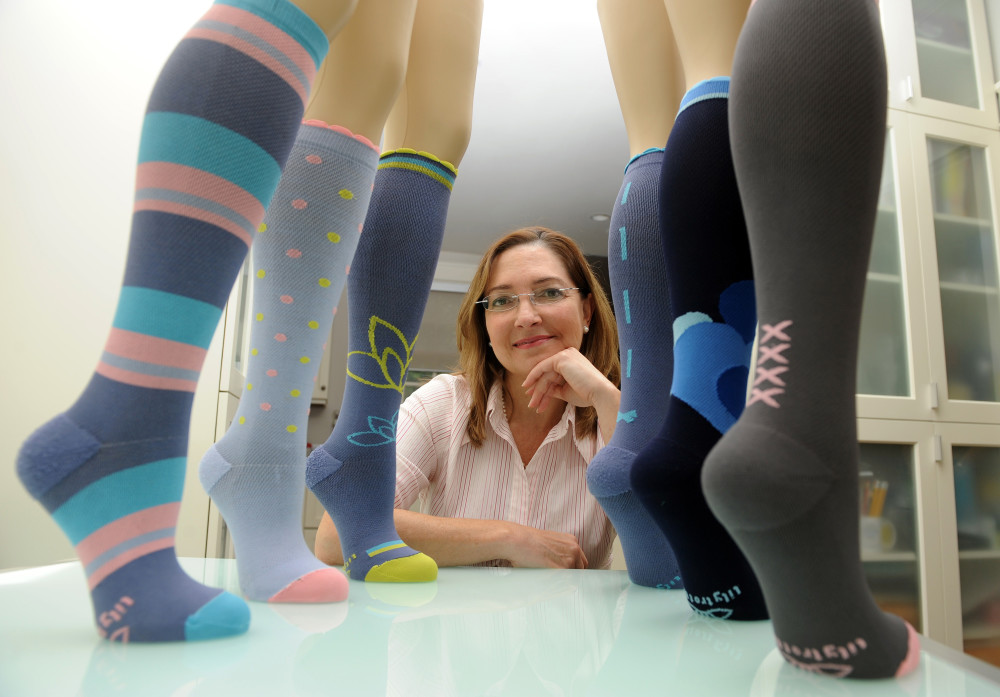By Carrie Wells
The Baltimore Sun.
BALTIMORE.
Mannequin legs line the walls of Susan Costa-Walston’s dining room, sheathed in knee-high socks in blue, gray and polka-dot patterns.
Compression socks, once used only for medical purposes like preventing blood clots, have been gaining popularity in recent years among runners, nurses, travelers and those who spend a lot of time on their feet. But according to Costa-Walston, most options are either boring, medical-grade compression socks or those designed for athletes, which can be thick and difficult to pull on.
So Costa-Walston created Lily Trotters, a line of compression socks for women in five patterns. To gauge interest and raise money to launch her business, she turned to the crowdfunding website Kickstarter, offering early adopters discounted socks in exchange for their investment. The campaign more than doubled her goal.
“The biggest challenge we have is most women don’t know what compression is,” Costa-Walston said. Some runners, Crossfit athletes and nurses are familiar with it, “but it’s still basically an unknown concept to most.”
Compression socks have long been used by hospitals and doctors to treat edema, varicose veins, phlebitis, and other vein and swelling issues. More recently, they have caught on among runners and other athletes, with manufacturers claiming the socks reduce injuries such as shin splints, improve performance and aid recovery.
Costa-Walston said she was turned on to compression socks four years ago when a friend recommended she wear them on a forthcoming 17 1/2-hour flight to Johannesburg.
“I’ve always been the kind of traveler that would be jiggling around, getting up, and in that 17 { hours, I never felt that need,” she said.
buy levitra generic buy levitra online no prescription
“When we got to Johannesburg, my legs felt amazing.”
When she got home to Baltimore, she recalled, “I couldn’t wait to find some pretty ones.” But she couldn’t find any.
A former graphic designer who took time off work to raise her daughter, who is now high school age, Costa-Walston was looking for a “second career” and decided to design her own socks.
She came up with five designs in a variety of colors: polka dot, hearts, a lotus flower, one with four Xs on the heel called “four kisses” and another with a bow tie she calls “sassy bow.”
She called around to different hosiery mills before finally finding one in North Carolina that would take on the fledgling project.
One of the hardest parts of launching the product, Costa-Walston said, was coming up with a name. Finally, she said, her daughter stumbled onto an idea. They called them Lily Trotters, after a long-legged water bird they saw while on vacation in South Africa.
The Lily Trotters are made of microfiber and are thinner than typical athletic compression socks. The compression is measured in what is called millimeters of mercury. Her socks have around 15 to 20 millimeters of mercury, a moderate level of compression that is below medical grade.
She’ll use the money from the Kickstarter campaign, $46,754 from 530 backers, to fund her first production run. She was thrilled to exceed her $20,000 goal.
Kickstarter’s success rate for fully funding projects is a little over 37 percent, the company said.
Costa-Walston said she plans to offer Lily Trotters for sale online this fall, priced at about $65. She is also considering a men’s line, though she said some men donated to the Kickstarter campaign to score discounted pairs and were not bothered by the girly designs.
She also plans to pitch the socks to local running stores and hopes to grow from there.
Charm City Run in Baltimore has been selling compression socks for a few years, said its manager, Deirdre Weadock. The buyers aren’t just runners but include patients at a vein clinic that happens to be across the street, she said.
“I don’t know if people knew what they were in 2010, but by 2011 they were starting to become fairly commonplace at events,” Weadock said. “And now it’s almost like more runners wear them than not, or have a pair at least in their rotation.”
Whether compression socks truly provide an athletic benefit is up for debate. A study published in the Journal of Strength and Conditioning Research this year found that wearing compression socks for 48 hours after running a marathon improved performance on a treadmill test two weeks later. But two Indiana University studies published in 2010 found that compression garments did not improve performance, with the authors arguing that any benefit may be psychological.
But there’s no denying their growing popularity.
A report this year in the trade publication Textiles Intelligence noted that the market for compression garments is dominated by a handful of companies, which include Under Armour, but that new companies are joining the fray and the sector is expected to grow in the coming years.
Costa-Walston said she’s not too worried about competing with more established players.
“I think there’s a lot of legs in the world,” she said.














































































































































































































































































































































































